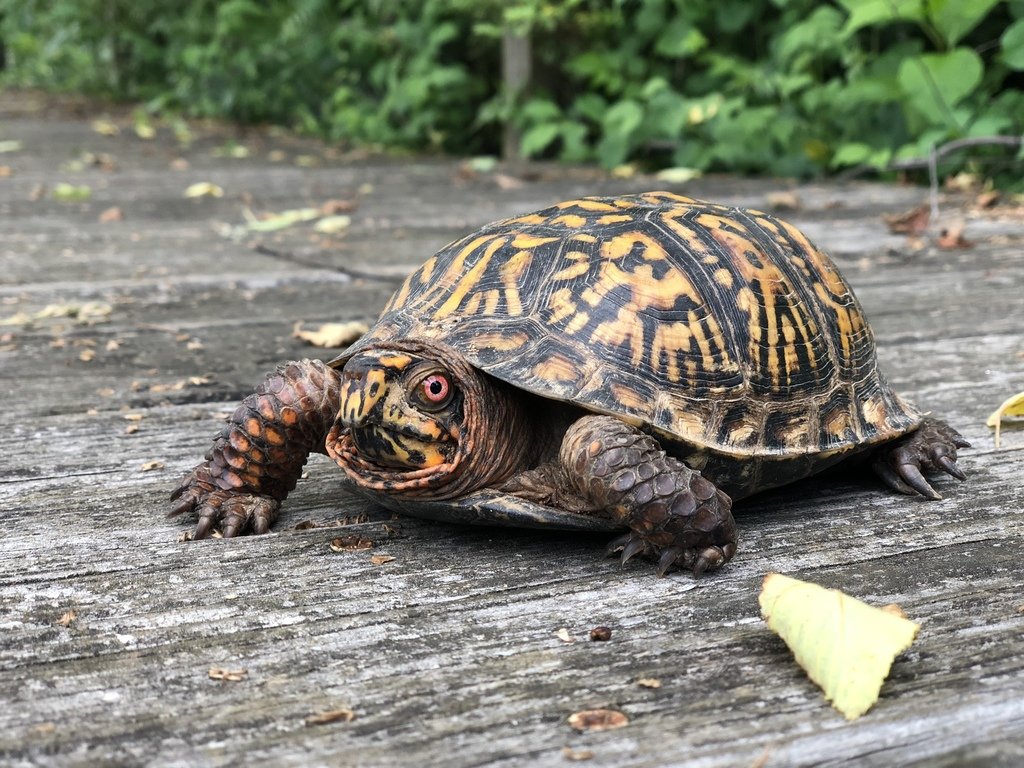Get to Know the Eastern Box Turtle
Turtles have roamed Earth since the days of the dinosaurs, with fossils found older than 220 million years. The United States, home to over 60 turtle species, is a global epicenter for turtle biodiversity and is home to more species than any other country. Some species are found only in the US, like the eastern box turtle (Terrapene carolina carolina), which is threatened due to habitat destruction, illegal collection, and car strikes.
These ancient animals play an important role in our environment. For example, a scientific study showed that seeds dispersed by turtles have a higher probability of germinating, and some plant species, like the mayapple (Podophyllum peltatum), fully depend upon eastern box turtles to spread their seeds.
Here’s a collection of cool turtle facts to enhance your chelonian appreciation:
Turtles are very long-lived, with an average lifespan of 40-60 years. They don’t reach maturity until roughly 4 years old and aren't fully grown until 20 years old.
The eastern box turtle is the official Tennessee state reptile.
Turtles live peacefully, often sharing territory with 3-4 other turtles.
Female eastern box turtles mate one time per year laying 1-11 eggs. They can store sperm in their oviducts and produce fertilized eggs for around 4 years after mating.
Box turtles are homebodies. They are mostly found within 250 yards of the nest they were born in and travel approximately 55 yards per day.
As an opportunistic omnivore, these little tanks will eat almost anything including fungi, insects, birds, eggs, plants, slugs, berries, and grasses.
A sure way to distinguish male from female is by looking at their plastron (the undershell). Females have a flat plastron while males have a concave scoop in theirs. Also, males sometimes have red eyes while females sometimes have brown eyes.
They are terrestrial and do not swim well, but they enjoy relaxing in shallow puddles.
The box turtle's hinged shell, fully developed at 4-5 years old, allows them to close completely, protecting them from predators. If the shell is damaged, it can regenerate!
From May through July, female box turtles dig holes in the soil to lay their eggs. Afterward, the eggs are left to hatch after a 2-3 month incubation. The temperature of the nest determines the sex of the hatchlings. Warmer nests tend to produce females, while cooler nests produce males - a distinction known as environmental sex determination. Imagine how climate change affects turtles!
Box turtles can be found in a variety of habitats from fields to forests, preferring moist situations when possible. Apart from feeding, much of a turtle’s time is spent buried in the cool leaves and dirt of the forest floor.
In the winter months, eastern box turtles enter into brumation, the reptile form of hibernation. They bury into the forest floor in a hibernaculum and enter into a winter lethargy, waking up for spring as the photoperiod and temperatures increase.
Turtles play many vital roles within our ecosystem including predator, prey, decomposer, seed sower, and ecosystem engineer. To have a sustainable population, adult turtles need to reproduce their entire lives. That means the loss of adult turtles has perilous implications for future generations. Additionally, as ecosystem engineers, turtles benefit other wildlife, fish, and plants that share their habitats. According to a BioScience magazine scientific paper, “in the context of ecosystem processes and services… turtles assume all the traditional trophic positions of consumers, thus the removal of turtles could have profound effects on the structure and function of terrestrial, freshwater, and marine communities. For instance, the removal or diminished role of turtles in the wild can be far-reaching and create trophic cascades, altered biomass structure, loss of community function, and invasive species resilience, all of which are critical to maintaining healthy ecosystems.”
Next week, learn all about how you can help conserve turtles wherever you are!
Mark McKnight, our CEO, took all the great box turtle photos on this page.






